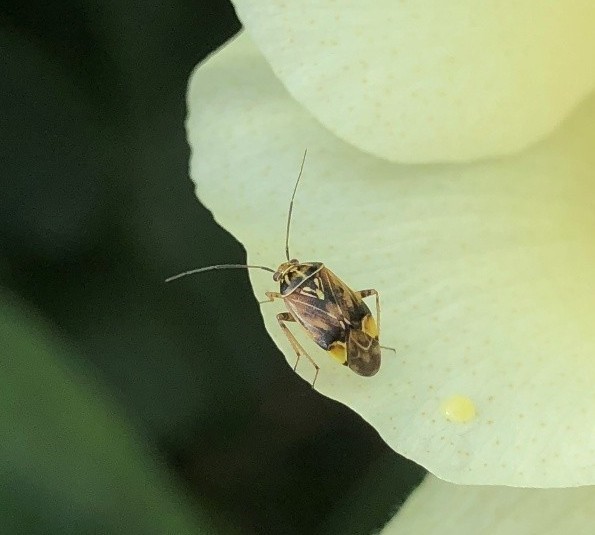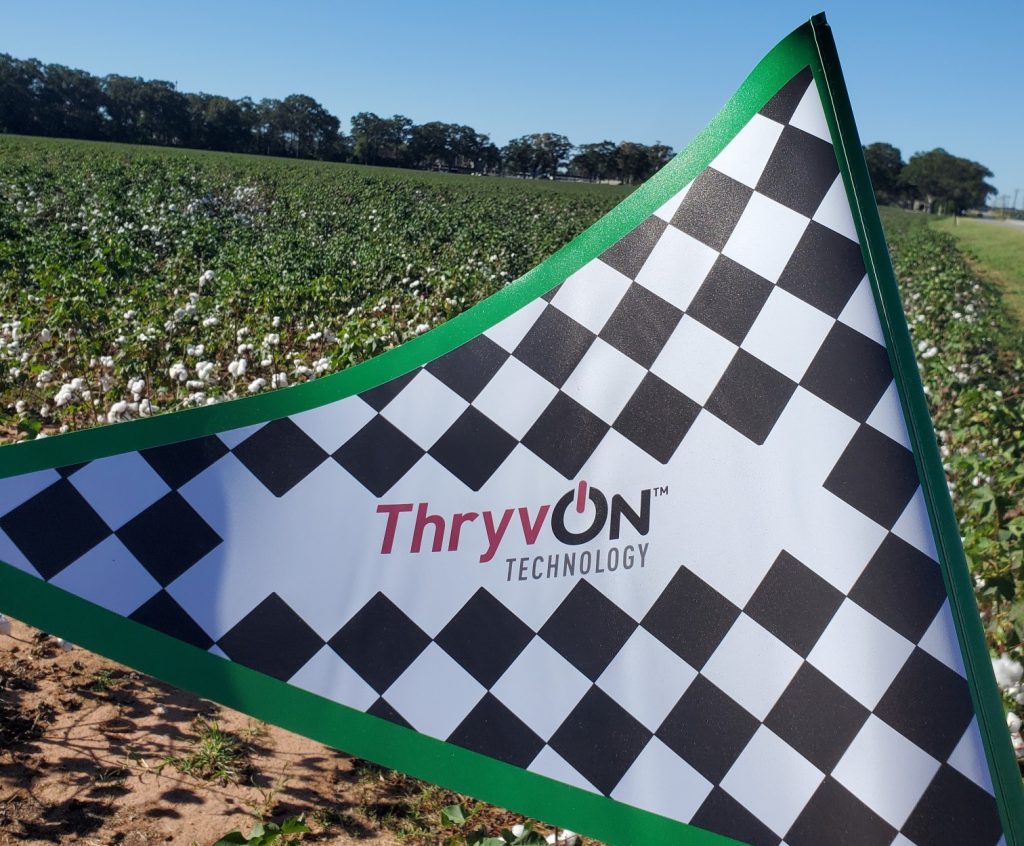Dr. Scott Graham and Dr. Ron Smith, Auburn Entomologists in “February 16, 2023 Cotton Shorts”
The new cotton technology expressing the Bacillus thuringiensis (Bt) protein Cry51Aa2, referred to as “ThryvOn” and developed by Bayer CropScience, will be commercially available beginning in the 2023 growing season. ThryvOn is unique from all other currently used technologies in cotton integrated pest management (IPM). This technology has activity against two key insect pest species of cotton, thrips (importantly, tobacco thrips, Frankliniella fusca), and tarnished plant bug (Lygus lineolaris). ThryvOn has been documented to reduce populations of both species during the critical periods of the season in which they cause economic losses.

Tarnished plant bug (Lygus lineolaris) on cotton bloom, photo courtesy of Dr. Graham.
–
How ThryvOn Works: Tarnished Plant Bugs
In addition to thrips, ThryvOn technology also has activity on tarnished plant bugs. Insecticide resistance and other changes in the landscape have led to an increase in the pest status of plant bugs across the Southeast. Like thrips, adult non-preference plays a role in the reduced plant bug populations and damage found in ThryvOn cotton. In addition to feeding less, adult plant bugs also deposit fewer eggs in ThryvOn. Although populations and injury are less in ThryvOn cotton compared to non-ThryvOn cotton, threshold populations and injury can be observed and may require treatment.
In pre-bloom cotton, the currently recommended threshold is 8 adult plant bugs per 100 sweeps or to maintain 80% square retention. The use of an either/or approach is critical for plant bug management in current varieties and will likely be important in ThryvOn cotton as well. Although the threshold population of 8 bugs may not often result in >20% pinhead square loss, adult plant bugs are also depositing eggs that will hatch out into immatures over the following weeks. Proper scouting and insecticide timing can help to reduce the populations of immature plant bugs observed in cotton in early bloom.
As cotton develops into bloom, immature plant bugs become the focus for scouting efforts as fewer adults are observed during the first two weeks of bloom. Immature plant bugs prefer to feed on larger squares, often hidden inside bracts, making insecticide coverage difficult. One way that ThryvOn helps with plant bug management is increased efficacy of insecticides. This is likely due to a couple of factors. One factor is that immature plant bugs are thought to move around more in the plant canopy as they, like adults, are looking for other sources of food. Unlike adults, however, they are unable to move from the field to other hosts. This likely leads to immature plant bugs coming into more contact with insecticides as they are moving around the plant and outside of bracts on large squares. Another factor that helps control immature plant bugs is delayed maturity of immature plant bugs. After feeding on ThryvOn, immature plant bugs do not develop as quickly (i.e., get as large) as they normally do. Much like humans, or any other animal, plant bugs feed (i.e., damage) more as they get larger. This leads to less damage, such as dirty squares and blooms, in cotton even if threshold populations of plant bugs are observed.
The recommended threshold for immature plant bugs is 3 per 5 row feet, sampled with a block drop cloth. To date, research done in the Southeast suggests this threshold should be followed in ThryvOn cotton as it is in non-ThryvOn cotton. One advantage of ThryvOn cotton is that often, in low plant bug pressure areas, populations build slower than in non-ThryvOn cotton. This means that the window of opportunity to spray is longer. In other words, in rainy periods or in areas where fields are spaced out across large areas, the timeliness of the insecticide application is not as great. While timeliness will still be important, plant bugs are not doing as much damage in the lag time between sprays.

Thryvon cotton in Jay, FL
–
How to Utilize ThryvOn: Plant Bugs
Often, plant bug infestations are heaviest in earlier planted cotton. This is because as adult plant bugs begin to migrate from weedy hosts to cotton in June, older fields are the most attractive because more food sources (squares) are present. One way to maximize the impacts of ThryvOn cotton for plant bugs in the Southeast is to plant these varieties earliest, as they have the highest likelihood of plant bug infestations. Another consideration is planting near corn. Often, plant bug pressure is higher on field borders next to corn. ThryvOn varieties could be placed on these borders to take advantage of the reduced injury found under high pressure, compared to non-ThryvOn varieties. However, another consideration is that insecticide applications will still be needed, likely the same number of applications needed in non-ThryvOn cotton. Thus, ThryvOn varieties could also be planted in blocks away from corn or other sources of plant bugs. By placing ThryvOn in areas with lower expected plant bug pressure, the likelihood of reducing or eliminating plant bug applications may be increased. These decisions will need to be made on a farm-to-farm basis.
–
ThryvOn Take Home Points: Plant Bugs
The impacts of the ThryvOn on plant bugs may not always be as obvious as thrips, but this technology will have a fit in Southeastern cotton. Some benefits, such as reduced injury and delayed population development, may be “hidden.” In other words, while this technology may not always eliminate or reduce the need for insecticide applications for plant bugs, less damage incurred helps preserve yield in other ways. Proper scouting, monitoring, use of thresholds and insecticide selection will still be critical for plant bug management in ThryvOn cotton.
In a later edition of the Alabama Cotton Shorts, Dr. Graham and Dr. Smith will detail how to maximize thrips control with ThryvOn cotton.

Scott Graham, Auburn Row Crop Entomologist
- Surprise!January WASDE Report Moves Corn and Soybeans Lower – Cotton Flat - January 16, 2026
- Don’t Ignore Cow Size When Comparing Calf Weaning Weights - January 9, 2026
- Federal Estate Tax and Gift Tax Limits Announced For 2026 - December 19, 2025
